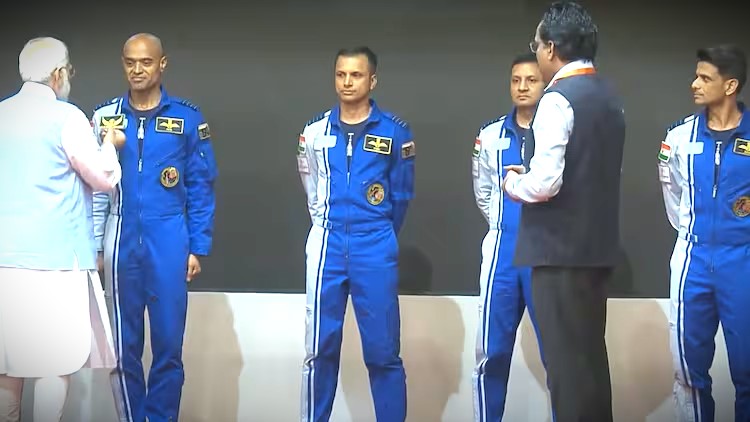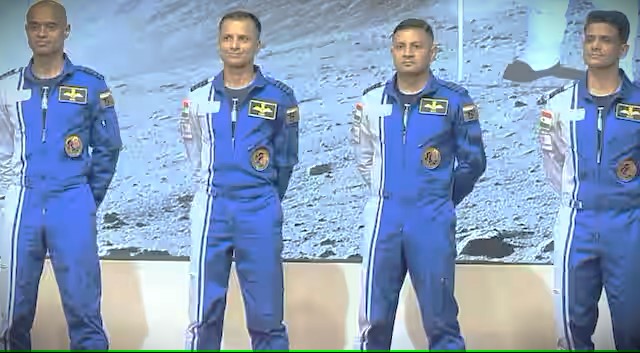On Tuesday, Prime Minister Narendra Modi gave wings to astronauts and introduced the astronauts of the Gaganyaan mission to the world. Four Indian Air Force officers will become the first Indians to fly into space from mainland India in an indigenous spacecraft.
The four astronauts are Group Captain Prashant Balakrishnan, Group Captain Ajit Krishnan, Group Captain Angad Pratap, and Wing Commander Shubhanshu Shukla.

In Short
- Prime Minister Modi gave an update on the Gaganyaan mission’s status.
- The goal of the Gaganyaan mission is to place three astronauts in low Earth orbit.
NASA’s Gaganyaan mission involved a rigorous selection and training process for astronauts.
The four astronauts are Group Captain Prashant Balakrishnan, Group Captain Ajit Krishnan, Group Captain Angad Pratap, and Wing Commander Shubhanshu Shukla.
The four astronauts have undergone extensive training in Russia, and the program is currently underway at India’s ISRO training facility.
Prime Minister Narendra Modi gave a standing ovation to the four astronauts and said, “We are witnessing another historic journey at the Vikram Sarabhai Space Centre. These are not just four names, but an entity that carries forward the aspirations of astronauts.” 140 million Indians go to space.
PM Modi reviewed the progress of the Gaganyaan mission at VSSC and interacted with Vyomitra, the first humanoid robot to be launched on the Gaganyaan mission, before the astronauts stepped into the crew capsule.
The Gaganyaan mission aims to carry a crew of three astronauts into low Earth orbit. With this initiative, India will become the fourth country in the world to independently send humans to space after the United States, Russia, and China.
The Gaganyaan spacecraft is designed to accommodate astronauts and is developed with advanced technology to ensure the safety and success of the mission. The spacecraft will be equipped with life support systems, communication systems, and other necessary facilities to sustain human life in space.
The selection and training of astronauts for the Gaganyaan mission was rigorous and extensive. Selected astronauts will undergo intensive training in areas such as space navigation, survival skills, and simulated space missions to prepare them for the challenges of space travel.
The Prime Minister was at the Vikram Sarabhai Space Center in Thiruvananthapuram. This was his first visit to ISRO Headquarters.
Along with revealing the names of the Gaganyaan astronauts, the Prime Minister also inaugurated the PSLV Integration Facility, the Semi-Cryogenic Integrated Engine and Stage Test Facility at Mahendragiri, and the Trisonic Wind Tunnel at VSSC.
The PSLV Integration Facility aims to increase the frequency of PSLV launches from six to 15 per year. Additionally, as the PMO noted, it is designed to accommodate launches of mini-PSLVs, small satellite launch vehicles, and other small launch vehicles developed by private space companies.
Meanwhile, the new Semi-Cryogenic Integrated Engine and Stage Test Facility at IPRC Mahendragiri will enable the development of semi-cryogenic engines and stages that will enhance the payload capabilities of current launch vehicles. The facility is equipped with liquid oxygen and kerosene supply systems for testing engines with thrusts up to 200 tonnes.
Also Read:
About the Gaganyaan mission
The Gaganyaan mission is India’s first manned space mission and is targeted to launch in 2024–2025. The project envisages launching a three-member crew into a 400-kilometer orbit for a three-day mission, landing in Indian waters, and returning safely to Earth.

According to an ISRO release, the mission will be achieved through optimal strategies that will take into account domestic expertise, the experience of Indian industry, the intellectual capacity of Indian education and research institutions, and cutting-edge technology available from international organizations. It will be done.
Last week, ISRO successfully completed human evaluation of the CE20 cryogenic engine, giving a major boost to India’s mission launches.
“ISRO completed the final round of ground qualification tests on February 13, 2024, marking a major milestone in the human evaluation of the CE20 cryogenic engine that will power the cryogenic stage of the human evaluation LVM3 rocket for the Gaganyaan mission.” The test was the seventh in a series of vacuum ignition tests conducted at the High Altitude Test Facility at ISRO Propulsion Facility, Mahendragiri, to simulate flight conditions, ISRO said in a statement.
The Gaganyaan mission aims to carry a crew of four astronauts into low Earth orbit. With this initiative, India will become the fourth country in the world to independently send humans to space after the United States, Russia, and China.
The famous Indian LVM3 rocket, which was used to launch the Chandrayaan-3 mission, will be the launch vehicle for the Gaganyaan mission. It consists of a solid phase, a liquid phase, and a cryogenic phase.
All systems of the LVM3 rocket have been reconfigured specifically to meet human requirements for the Gaganyaan mission and have been given a new name: Human-Rated LVM3. According to ISRO, HLVM3 will be capable of launching the orbital module into a designated 400 km low Earth orbit.
Gaganyaan mission: The Indian space agency is preparing to achieve a new milestone in its space endeavors with the launch of the Gaganyaan mission, scheduled to launch in 2024. Preparations for India’s first manned mission have been going on for years, with preliminary research for the mission underway. Back in 2006.
Gaganyaan, which literally means “celestial vehicle,” will carry four people on a three-day mission to a 400-km orbit, land in Indian waters, and return safely to Earth.
On Tuesday (February 27), Indian Prime Minister Narendra Modi visited the Vikram Sarabhai Space Center (VSSC) in Thiruvananthapuram and announced the names of the four Indian astronauts selected for this unique mission.
Group Captain Prashant Balakrishnan Nair, Group Captain Ajit Krishnan, Group Captain Angad Pratap, and Lieutenant Colonel Shubhanshu Shukla have been selected for the manned Gaganyaan mission.
Prashant Balakrishnan Nair hails from Nenmala town in Kerala and joined the Indian Air Force in 1999. In 1998, he received the Sword of Honor, a prestigious award given to the cadet who achieves the highest level of performance during training. He was also a holder of the first class of the US Air Force Air Command and Staff College.
The Gaganyaan mission aims to send three astronauts into a 400-kilometer orbit and return after three days. India’s space agency, ISRO, is conducting several tests to prepare for the flight. A major test in October showed that the crew could escape safely if the rocket malfunctioned.
Who is selected for the Gaganyaan mission?

He invoked these four forces, which encapsulate the aspirations of the 1.4 billion people in this country. Prime Minister Modi spoke at the Vikram Sarabhai Space Center (VSSC) in Thumba near here, where the four astronauts were Group Captain Prashant Balakrishnan Nehru, Captain Angad Pratap, Wing Commander Ajit Krishnan, and Shubhanshu.
What is the purpose of the Gaganyaan mission?
The Gaganyaan mission aims to send three astronauts into a 400-kilometer orbit and return after three days. India’s space agency, ISRO, is conducting several tests to prepare for the flight. A major test in October showed that the crew could escape safely if the rocket malfunctioned.
Which companies are involved in the Gaganyaan mission?
There are four major companies involved in the mission. They include Pushpak Aerospace and Defense, KCP Infra Limited, Larsen & Toubro, and Tata Elxsi.
What are the three stages of Gaganyaan?
Gaganyaan Missions
- Mid-air drop test of a parachute system demonstrating the ability to successfully recover an orbiting space capsule.
- Flight testing of the test vehicle.
- Canceling the test to demonstrate crew evacuation in case of an emergency on the launch pad.
When will Gaganyaan be launched?
Gaganyaan Mission: The Indian space agency is preparing for the 2024 launch of the Gaganyaan mission, which is expected to mark a significant advancement in its space activities.
When was Gaganyaan started?
History of the Gaganyaan programme. Initial research and technical development of Gaganyaan began in 2006 under the general name “Orbital Vehicle.”. The plan was to design a simple capsule that would stay in space for about a week, carry two astronauts, and splash down after re-entering the atmosphere.
Where was Gaganyaan launched?
Sriharikota
Earlier in the day, ISRO launched Abort Mission-1 (TV-D1), the first flight test vehicle of Gaganyaan, five seconds before liftoff from the Satish Dhawan Space Center in Sriharikota. However, the reason for the launch delay has been identified and rectified, ISRO said.
follow me : Twitter, Facebook, LinkedIn, Instagram
